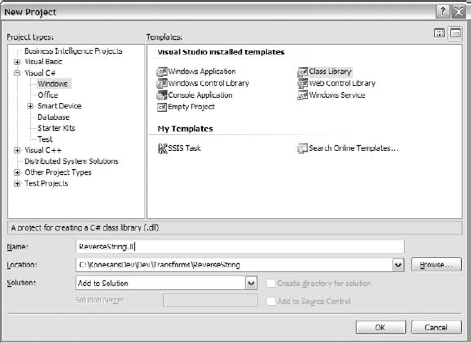15.2. Building the User Interface
Now that the key stages have been explained, you can examine each of them in detail. This guidance makes very few assumptions, explaining all the actions required; so as long as you can open Visual Studio on your own, you should be able to follow these steps, and perhaps more importantly understand why.
15.2.1. Adding the Project
If you followed the example in the previous chapter, you currently have an existing solution in Visual Studio 2005 that contains the pipeline component project (ReverseString). Therefore, your first step is to add a new Class Library project to host the UI, as shown in Figure 15-1. Although the UI can be implemented within the pipeline component project, for performance reasons this is not the recommended approach. Because SSIS has distinct runtime versus design-time elements, the combination of the two functions leads to a larger assembly, which requires more memory and consequently lower runtime performance. The separate design practice also allows for easier code development and maintenance, reducing confusion and conflicts within the areas of code.
Figure 15.1. Figure 15-1

Starting with the empty project, the first task is to configure any project properties, so you need to set the Assembly name and Default namespace to be consistent with your development practices, as shown in Figure 15-2.
Figure 15.2. Figure ...
Get Professional SQL Server™ 2005 Integration Services now with the O’Reilly learning platform.
O’Reilly members experience books, live events, courses curated by job role, and more from O’Reilly and nearly 200 top publishers.

